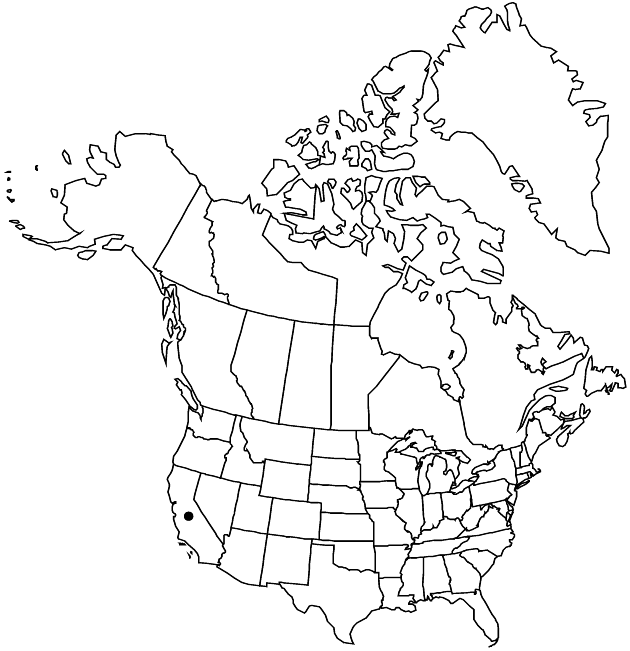Difference between revisions of "Lessingia pectinata var. tenuipes"
Madroño 52: 60. 2005.
Basionym: Lessingia germanorum var. tenuipes J. T. Howell Univ. Calif. Publ. Bot. 16: 22, figs. 20, 21. 1929
Synonyms: Lessingia germanorum var. vallicola J. T. Howell
FNA>Volume Importer |
FNA>Volume Importer |
||
| Line 7: | Line 7: | ||
|year=2005 | |year=2005 | ||
}} | }} | ||
| − | |basionyms={{Treatment/ID/ | + | |basionyms={{Treatment/ID/Basionym |
|name=Lessingia germanorum var. tenuipes | |name=Lessingia germanorum var. tenuipes | ||
|authority=J. T. Howell | |authority=J. T. Howell | ||
| + | |publication_title=Univ. Calif. Publ. Bot. | ||
| + | |publication_place=16: 22, figs. 20, 21. 1929 | ||
}} | }} | ||
|synonyms={{Treatment/ID/Synonym | |synonyms={{Treatment/ID/Synonym | ||
| Line 29: | Line 31: | ||
|elevation=100–1700 m | |elevation=100–1700 m | ||
|distribution=Calif. | |distribution=Calif. | ||
| − | |discussion=<p>As here circumscribed, <i></i>var.<i> tenuipes</i> includes plants that have a colored band in corolla tubes and truncate-penicillate style-branch appendages. Others have treated those plants as <i>Lessingia glandulifera </i>var.<i> glandulifera</i>. Herein, the latter name is applied elsewhere in the genus (plants that lack a colored band in corolla tubes and have lanceolate style-branch appendages). Variety tenuipes is known from the San Francisco Bay area, Great Central Valley, Sierra <i>Nevada</i> foothills, South Coast Range, and southwestern California.</p> | + | |discussion=<p>As here circumscribed, <i></i></i>var.<i><i> tenuipes</i> includes plants that have a colored band in corolla tubes and truncate-penicillate style-branch appendages. Others have treated those plants as <i>Lessingia glandulifera </i>var.<i> glandulifera</i>. Herein, the latter name is applied elsewhere in the genus (plants that lack a colored band in corolla tubes and have lanceolate style-branch appendages). Variety tenuipes is known from the San Francisco Bay area, Great Central Valley, Sierra <i>Nevada</i> foothills, South Coast Range, and southwestern California.</p> |
|tables= | |tables= | ||
|references= | |references= | ||
| Line 53: | Line 55: | ||
|publication year=2005 | |publication year=2005 | ||
|special status= | |special status= | ||
| − | |source xml=https://jpend@bitbucket.org/aafc-mbb/fna-data-curation.git/src/ | + | |source xml=https://jpend@bitbucket.org/aafc-mbb/fna-data-curation.git/src/f6b125a955440c0872999024f038d74684f65921/coarse_grained_fna_xml/V19-20-21/V20_1050.xml |
|tribe=Asteraceae tribe Astereae | |tribe=Asteraceae tribe Astereae | ||
|genus=Lessingia | |genus=Lessingia | ||
Revision as of 18:39, 24 September 2019
Stems green or tan. Leaf margins entire or dentate to pinnately lobed (segments not cuspidate). 2n = 10.
Phenology: Flowering May–Oct.
Habitat: Coastal scrub, woodlands, pine forests, desert scrub, sometimes sandy soils
Elevation: 100–1700 m
Discussion
As here circumscribed, var. tenuipes includes plants that have a colored band in corolla tubes and truncate-penicillate style-branch appendages. Others have treated those plants as Lessingia glandulifera var. glandulifera. Herein, the latter name is applied elsewhere in the genus (plants that lack a colored band in corolla tubes and have lanceolate style-branch appendages). Variety tenuipes is known from the San Francisco Bay area, Great Central Valley, Sierra Nevada foothills, South Coast Range, and southwestern California.
Selected References
None.
Lower Taxa
None.
